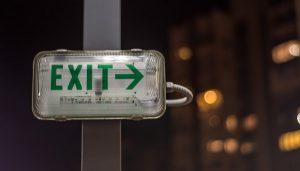
As an employer, you’re responsible for making your workplace a safe environment for staff and visitors. As part of these duties, you need to make sure there are enough fire exits on your premises.
Fail to comply with the fire exit door requirements and you’ll not only put your employees in danger, but may be found liable for any preventable deaths or injuries caused in the event of a fire. It’s therefore crucial that you ensure there are enough escape routes on your premises.
If you’re wondering how many emergency exits you need and where they need to be placed, we’ve put together this easy-to-read guide to answer all your questions. So, read on to find out:
If you’re an employer in the UK, you’re responsible for fire safety on your premises and you need to abide by the government’s health and safety regulations. If you fail to follow these you could be fined or even sent to prison.
Fire safety regulations are part of the government’s health and safety rules. They’re enforced by officers from your local fire and rescue service, who have the right to enter a premises for inspection at a reasonable hour without giving notice.
However, England and Wales, Scotland, and Northern Ireland all have slightly different fire safety regulations.
If you run a business in England or Wales, you must abide by the Regulatory Reform (Fire Safety) Order 2005.
If your company is based in Scotland, you should refer to the Fire Safety (Scotland) Regulations 2006.
If your business is located in Northern Ireland, you’ll need to abide by the Fire Safety Regulations (Northern Ireland) 2010.
While you should be sure to read the fire safety regulations that apply to you in full, the advice on fire exits we’ve presented in this guide applies no matter where in the UK your business is based.
Before we look at how many fire exits you need to have on your business premises, it’s important that we define exactly what a fire exit is.
According to the Regulatory Reform (Fire Safety) Order 2005, the Fire Safety (Scotland) Regulations 2006, and the Fire Safety Regulations (Northern Ireland) 2010, a fire exit (also known as an emergency exit) must:
And, according to these fire exit regulations, if your premises are used by the public or you have a lot of employees, your fire exits should also open via push bars or pads, as our fire exit doors do.
If there is only one emergency exit on your site, it must be fire-resistant. Our steel fire doors are CERTIFIRE accredited to FD240, making them the perfect choice for a lone fire exit. If you want to get up to speed on fire ratings, read our guide to fire ratings before you place your order.

A fire escape route is a path that leads to a point of safety, such as a fire exit or protected stairwell. Everyone on your premises should be able to follow this route without the aid of the fire and rescue service, and it must follow the shortest distance possible.
The fire exit regulations recommend that there are at least two escape routes from every part of premises that are completely independent of each other. This will ensure there’s always a route your staff can take to evacuate the building.
Every door on an escape route should open in the direction of escape and be easy to open without the use of a key. If you install steel fire doors along your escape routes, you’ll ensure that they keep your staff as safe as possible.
The government’s guidance doesn’t give any hard and fast rules about how many fire exits your business premises needs. However, there are guidelines you need to follow to comply with fire safety regulations. We’ve condensed these here, but you should make sure to read the government’s regulations in full so you’re absolutely clear about your duties as an employer.
The government recommends that you provide more than one fire exit from your premises whenever it’s possible. These exits should be completely independent of each other and have separate escape routes so there’s always a way to evacuate the building in an emergency.
You should also take efforts to ensure the distance people need to travel to evacuate the premises is as short as possible. If a building has multiple fire exits, there should be no point that is more than 60 metres away from the nearest escape route. If there is a high chance of a fire starting on your premises, the furthest point from a fire exit should be less than 25 metres.
The government recognises that it sometimes isn’t possible to provide more than one fire exit on small premises.
If you’re unable to provide an alternative escape route, there should be no point in the room that is more than 25 metres away from your main fire exit. If there is a strong likelihood of a fire on your premises due to the nature of your business, this must be 12 metres or less.
If there is only one fire exit on your premises, you must make sure it’s fire-resistant, like our steel fire doors.
In short, there should be access to an escape route every:
Very small and straightforward premises might be able to satisfy these criteria without any alterations. If you own a larger site, you should get acquainted with the government’s fire safety regulations so you’re absolutely certain of what you need to provide in the way of emergency exits and fire safety equipment. If you’re unsure, you can contact your local fire service for guidance.

If you fail to follow the government’s fire exit regulations, you could be fined or even sent to prison if a fire on your premises causes preventable death or injury.
The local fire and rescue authorities also regularly visit business premises to check that they’ve provided adequate fire safety precautions. If this reveals that your site doesn’t have enough fire exits, you’ll be issued with a formal fire safety notice, which will detail what changes you need to make and when you need to make them by. If you fail to comply with this notice within the specified time period you could be fined, and in severe cases even sent to prison.
If you have any questions about fire exits that haven’t been answered in this guide, don’t hesitate to get in touch with one of our friendly experts today, who’ll be more than happy to help with your query. If not, be sure to browse our ranges of fire exit and fire rated doors, which will help you meet fire safety regulations.
Please bear in mind that the information presented in this short guide is not comprehensive, and you should make sure to refer to the Regulatory Reform (Fire Safety) Order 2005, the Fire Safety (Scotland) Regulations 2006, or the Fire Safety Regulations (Northern Ireland) 2010 , and HM Government’s guide to making your premises safe from fire, for official guidance.